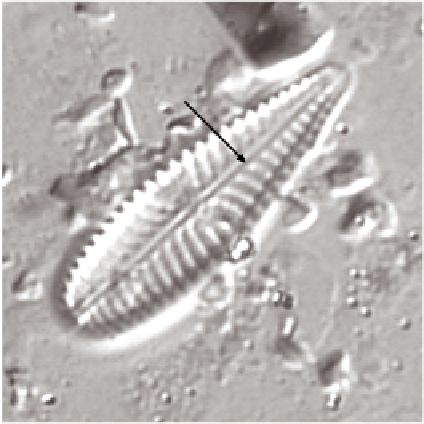Environmental Engineering Reference
In-Depth Information
Cells of
Peronia
(15-70 μm long, 2.5-
5.0 μm wide) are relatively straight and
heteropolar, with a subcapitate or bluntly
rounded apical end and a tapering, nar-
rowly rounded, base end. One valve has
an obvious raphe but the other only has
a rudimentary one. The valve surface is
finely striated, with small spines around
the edge. There are two chloroplasts, one
either side of the centre. Grows attached
to a substratum by means of a mucilage
pad. Found in acidic oligotrophic waters.
Bacillariophyta. Plate XXIV.
(b) Cells wider with either bluntly
rounded, capitate or rostrate upper pole
..................................
169
10 μm
Figure 4.68
Gomphonema.
Club-shaped diatom with
prominent central raphe (arrow). Acid digest, lake sed-
iment sample. Reproduced with permission from M.
Capstick.
169
(168) (a) Cells large (
60 μm) with markedly
capitate upper and lower poles, rather
like an Egyptian mummy in shape
.......................
Didymosphenia
>
Didymosphenia
cells (60-140 μm long,
25-43 μm wide) have markedly capitate
apices, with the apical end being larger
than the base. The central cell area is
inflated. The valve face has conspicu-
ous striae with a clear central area which
has 2-4 prominent stigmata on one side.
A single H-shaped chloroplast is present
with a central pyrenoid. Occurs on damp
rocks and other substrata, attached by a
mucilage stalk. Can occur in large num-
bers, when the mucilaginous stalks may
cause an obstruction to water flow. Bacil-
lariophyta. Plate XXV.
Egyptian mummy (
G. truncatum
and
G.
acuminatum
). The valve surface has fine
to obvious striae, parallel in some species
or radiate in others. There is a single
stigmaintheclearcentralarea.AsingleH-
shapedchloroplastispresentwithacentral
pyrenoid. Usually attached to a surface by
a single or branched mucilaginous stalk. A
widespread species in a range of waters.
Some species are reported as being sen-
sitive to pollution (
G. subtile
). Bacillario-
phyta. Plate XXV. Figs. 2.29 and 4.68.
170
(167) (a) Cells isopolar, linear-lanceolate to
elongate-elliptical in valve view, bent or
curvedingirdleview...............
171
(b) Cells bluntly rounded or rostrate,
upper pole at most slightly capitate
........................
Gomphonema
(b) Cells isopolar, lanceolate with
rounded or protracted apices but not
curved or bent in girdle view. . ......
176
Gomphonema
cells are heteropolar in
valve view but cuneate in girdle view.
Some species are only slightly heteropolar
(
G. angustatum
) whilst others are more
strongly heteropolar, somewhat like an
171
(170) (a) Cells with distinct costae extending
from margin to margin. Single much-
lobed chloroplast ..................
172

Search WWH ::

Custom Search